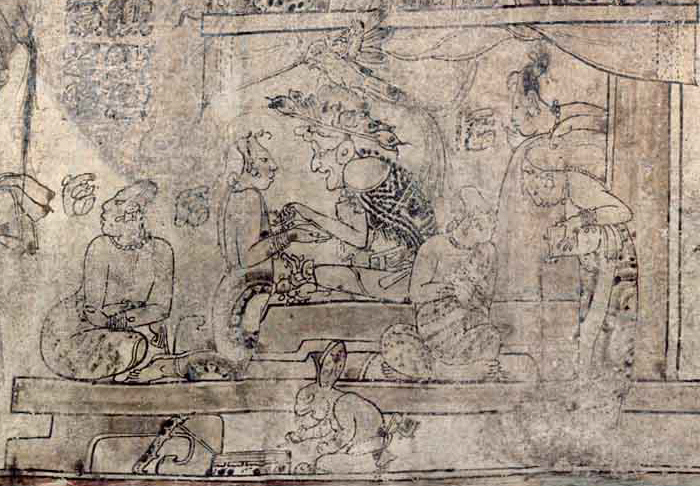Princeton Vase
Catalogue Entry:
The masterful calligraphic painting on the Princeton Vase is the finest known example of Maya "codex style" ceramic art. Graceful, sure lines painted on a cream slip present a theatrically composed mythological scene, while subtle visual devices encourage the viewer to turn the drinking vessel, adding a temporal unfolding to the visual experience. On one side (seen here), an old, toothless underworld god sits on a throne that is placed within a conventionalized depiction of a palace structure, represented by the pier behind him and what is likely a cornice above. The cornice is adorned with two jawless jaguars framing a frontal shark face. Curtains, which were used as doors among the ancient Maya, have been furled and tied to reveal the old lord seated within. This deity, known among scholars as God L, wears his characteristic open-weave brocaded shawl and broad-brimmed hat bedecked with owl feathers and a stuffed owl with wings outstretched. In addition to ruling Xibalba, the Maya underworld, God L was the patron deity of tobacco and merchants. Five elegant female figures — daughters or concubines — surround him. Each wears a loose, flowing sarong, decorated with batik-like dyed patterns rendered in soft brown wash, and jewelry at the ears, neck, and wrists. One of the women behind God L pours chocolate, frothing the bitter delicacy from a vessel of the same form as the Princeton Vase. A rabbit scribe, who may be spying on God L, sits below, recording the actions of the scene in a book with jaguar-pelt covers. God L delicately ties a bracelet on the woman before him, while another woman taps her foot to draw her attention—and the viewer’s—to the gruesome scene at left, in which two men wearing elaborate masks and wielding axes decapitate a bound and stripped figure. The victim’s serpent-umbilicus curls out to bite one of the executioners. The scene closely parallels a portion of the Popol Vuh, a sixteenth-century K’iche’ Maya mythological narrative wherein the Hero Twins trick the lords of the underworld into requesting their own decapitations. As is common in mythological narratives throughout the Americas, these heroes win the day not through Herculean feats of brute strength, but through cunning, and often humorous, trickery. The formulaic texts at the upper edge of the Princeton Vase serve to consecrate the vessel, to specify that it was intended for drinking "maize tree" chocolate, and to designate its owner, a lord named Muwaan K’uk’. The vase would have been used in courtly feasts similar to the scene depicted.
Gallery Label:
On this side of the famous Maya chocolate-drinking cup known as the Princeton Vase, an old, toothless underworld god sits on a throne within a palace, represented by the pier behind him and a cornice above. Curtains, which were used as doors among the ancient Maya, have been pulled up to reveal the interior scene. This deity, known among scholars as God L, wears his characteristic shawl and a broadbrimmed hat bedecked with owl feathers and an owl. In addition to ruling the Maya underworld, God L was the patron deity of tobacco and merchants. Five elegant female figures—possibly concubines— surround him. A rabbit scribe, who might be spying on God L, sits below, writing in a book.
A standing woman with her head bent in concentration suggests that the viewer rotate the vase to the left. She holds a vessel similar in size and shape to the Princeton Vase, and a stream of liquid pours down from it, presumably into a vessel whose rendering has eroded. This method of preparation likely frothed the bitter chocolate beverage that this vessel was made to serve. The vertical pier or rear wall of a palace structure marks the boundaries of the overall composition on this vase, placing the selfreferential vignette of vessel use at the end of the scene, as a sort of addendum.
The most important moment in the narrative of the Princeton Vase appears on this side of the vessel. Two men wearing elaborate masks and wielding axes decapitate a bound and stripped figure, seen at the lower left; the victim’s serpent-umbilicus curls out to bite one of the executioners. The scene closely parallels a portion of the Popol Vuh, a sixteenth-century K’iche’ Maya mythological narrative in which the Hero Twins trick the lords of the underworld into requesting their own decapitations. As is common in mythological narratives throughout the Americas, these heroes win the day not through feats of brute strength but through cunning, and often humorous, trickery.
With graceful, sure lines painted on a cream slip, the Princeton Vase presents a story that stretches around the entire object. Because passing or turning the drinking cup is necessary for full comprehension of the narrative, subtle visual devices between the primary scenes encourage the viewer to rotate the vessel, creating a temporal unfolding of the visual experience. Here, for example, a young noblewoman taps the foot of the woman in front of her while turning her head in the opposite direction: she is between two scenes and encourages her companion (and thus the viewer) to shift her attention around the vase.|
Plik jest wierną reprodukcją fotograficzną dwuwymiarowego utworu, znajdującego się w domenie publicznej z następującego powodu:
Zgodnie z oficjalnym oświadczeniem Wikimedia Foundation wierne reprodukcje dwuwymiarowych utworów z domeny publicznej są w domenie publicznej, zajmowanie przeciwnego stanowiska godzi w samą ideę domeny publicznej (więcej w: Commons:When to use the PD-Art tag).
Niniejsza reprodukcja jest więc również własnością publiczną. Użytkowanie tego dzieła może być zabronione lub ograniczane przez miejscowe prawo na obszarze jego jurysdykcji; patrz: Commons:Reuse of PD-Art photographs. | ||||
Więcej informacji o licencji można znaleźć tutaj. Ostatnia aktualizacja: Mon, 02 Jan 2023 12:01:54 GMT
